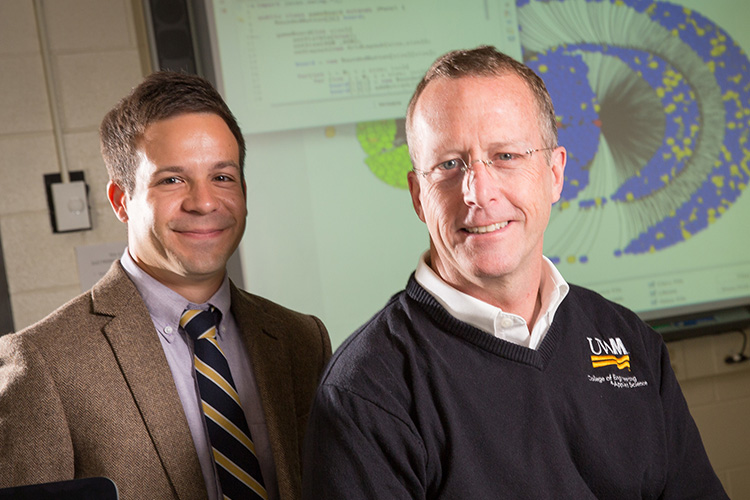From making renewable energy more affordable for consumers to medical imaging that makes accurate medical diagnoses faster and more cost effective, the UWM College of Engineering and Applied Science leads in research that improves lives and innovates industry.
Groundbreaking work in data encryption in the late 1960s helped the computer science program establish an international reputation, and a 1990 graduate of the master’s program may be one of the best-known computer scientists in the world. Today, Satya Nadella works in Seattle as CEO of Microsoft.
As the college celebrates its 50th anniversary, here’s a look at its rich research history and potential for the future.
A program ahead of its time
Years before the phrase “data security” worried the world, UWM researchers were pre-emptively attacking the problem.
George Davida, an electrical engineer who’s now an emeritus professor, was one of about a dozen faculty hired in the late 1960s for the newly created UWM College of Engineering and Applied Science. He delved into unbreakable codes that can hide information, quickly becoming one of the foremost leaders in the field and creating UWM’s Center for Cryptography, Computer and Network Security.
“Davida was way ahead of his time,” said K. Vairavan, hired in 1968 and now an emeritus professor of electrical engineering and computer science. “It was cutting-edge research in a developing field.”
Leonard Levine, also hired in the late 1960s, had a doctorate in physics but learned electrical engineering doing work for the space program and nuclear submarines during the Cold War. He said research was critical to the success of the new college. “We had to develop as a research institution, or no one would come.”
The college now enrolls more than 2,000 students, including more than 400 in graduate programs, has more than 9,000 alums, and is set to soon open a biomedical engineering program. Almost a quarter of current students attend part time, more than 20 percent of the college’s enrollment is made up of international students and 13 percent of its students are women.
Industry partnerships boost resumes, accelerate research, improve care
As part of its mission, the college continues to build partnerships with industry, adjusting its curriculum to provide employers with the workforce they need and giving students hands-on engineering experience to supplement their coursework and build resumes.
Jane Miceli chose UWM after hearing a talk by Levine in 2003 that emphasized the university’s industry connections.
“He talked about how it would be easier to find an internship and a job here,” said Miceli, now an Idaho-based consultant for Hewlett Packard and a mentor for women in IT. “I got an internship with Rockwell Automation and worked there for five years.”
Joint research by the university and industry drives the Center for Advanced Computational Imaging, created in 2014 in partnership with GE Healthcare to improve medical care by advancing 3-D imaging capabilities and reducing costs associated with powerful diagnostic tools like magnetic resonance imaging (MRI). Computer science Professor Ethan Munson directs the center, working with four professors who were awarded research grants by GE and a number of GE employees.
“UWM is located in the economic center of the state,” said Munson, who also serves as associate dean for academic affairs in the College of Engineering and Applied Science. “That proximity means that engineers (in the private sector) can do continuing education more easily and students can work directly with these companies.”
GE and Munson’s team also designed a 15-credit graduate certificate program around continuing education in computerized imaging. Paul Cunningham, a manufacturing engineering team leader at GE, combined the certificate program with other classwork and recently received his master’s degree.
“It grew my experience faster than if I had just been working,” Cunningham said of the program, adding that the mix of traditional professors and adjuncts working in the field was particularly helpful.
Jeffrey Kautzer, a UWM engineering graduate and now GE chief engineer and UWM adjunct professor, said the collaboration benefitting the university and GE also has a broader impact.
“Some of the work being done in the research projects has the potential to really make a big difference in the technology of our product, specifically reducing the cost of production,” Kautzer said. “This is broadly relevant considering health care costs today.”
Munson said there’s potential for collaborating with a number of major companies in the region on other uses of embedded systems – distinct, built-in computer systems that perform dedicated functions within a larger device or technology, powering everything from hybrid vehicles to digital watches.
“With local and global demand for engineers strong, our way forward for the next 50 years is to continue the tradition of excellence in areas of highest demand,” said Brett Peters, the college’s dean.








